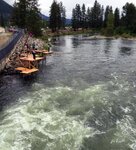


In this Anthropocene Era of climate change, perhaps the biggest challenge for the Western United States is its dwindling water supply, only exacerbated by the region’s widespread drought. Very few days pass without news of the crises that is the Colorado River drainage, water restrictions in California, or falling reservoirs and reduced mountain snowpacks throughout the West. Surely, though, Leavenworth and environs, tucked into the eastern flanks of the lush Cascades, are immune from this predicament. If only that was true.
Leavenworth’s primary water supply is Icicle Creek, via a water intake and filter plant located roughly five miles upriver from the creek’s terminus at the Wenatchee River. (The other source is drawn from an aquifer at the wellfield adjacent to Cascade Orchard Bridge on Icicle Road.) Steep and turbulent for much of its flow, Icicle Creek, the name of which is derived from the Native American word na-sik-elt, or narrow canyon, falls over 3,000 feet in 32 miles from its origin, Lake Josephine, near Stevens Pass, to its confluence with the Wenatchee, across from the Leavenworth Golf Club. The creek’s drainage basin is comprised of land within the Alpine Lakes Wilderness and the Wenatchee National Forest, and their glaciers, lakes, reservoirs, and streams.
Demands on the Icicle, however, are far from limited to the City of Leavenworth. In fact, there are myriad demands, which stand starkly in contrast to the comparatively static supply of water. That dichotomy leads the water supply to be stretched thin in times of plenty. In times of drought - most recently notable in 2015 – the Icicle’s flow can fail to meet its demands. That, in turn, can lead to a limitation upon, or even a cessation of, irrigation water to certain agricultural users, who are entitled to water on a “first in time, first in right” basis. In addition, the negative effects in time of drought extend to the creek’s fish habitat, operations at the Leavenworth National Fish Hatchery, and upon tribal fishing rights. Ultimately, it can, and has, lead to legal disputes among the Icicle’s water use stakeholders.
After a period of petitions for injunctions and lawsuits between and among the Icicle stakeholders, culminating with the Washington Department of Ecology seeking to limit the City of Leavenworth’s water rights, a proposal was made to create a coalition of those diverse, interested parties to avoid future litigation, if not disputes all together. All realized that a common core of each party’s position was an interest in having a healthy water system in the Icicle basin, with enough water for everyone. From that realization, and appreciation of a common interest, arose, in 2012, the Icicle Work Group. The Department of Ecology’s Office of the Columbia River, together with the Chelan County Natural Resource Department brought together municipal, state, and federal government agencies, tribal representatives, irrigation managers, hatchery administration, and environmental organizations. The Group included, among others, the two convening parties, the City of Leavenworth, the Colville Confederated Tribes, the Yakama Nation, the US Forest Service, the Washington Department of Fish and Wildlife, the Fish Hatchery, the Washington Water Trust, and the Peshastin and Icicle Irrigation District.
For six years, the Work Group met, collaborated, and compromised to devise a vision, strategy and slate of projects that would collectively form a sustainable water management plan to address the Icicle’s chronic water supply issues. The Icicle Strategy is based on a vision “to increase community and ecological resiliency through implementing collaborative solutions for water management within the Icicle Creek drainage to provide a suite of balanced benefits for existing and new domestic and agricultural uses, non-consumptive uses, fish, wildlife, and habitat while protecting treaty and non-treaty fishing interests.” The Guiding Principles, of the Icicle Strategy, incorporate over a dozen major projects, which were chosen by means of analyzing the “best available science to identify and support water management solutions that lead to implementation of high-priority water resource projects within the Icicle Creek drainage.”
The Group released an Environmental Impact Statement (EIS) in January of 2019 that “identified a mix of conservation and storage modification projects to achieve reliable water supplies and instream flows.” The projects include:
Alpine Lakes Reservoirs Optimization, Modernization, and Automation, which “modernizes and automates the outlet and gate infrastructure at seven Alpine Lakes within the Icicle Creek Subbasin.
Icicle-Peshastin Irrigation District Irrigation Efficiencies that includes “options to improve irrigation delivery and on-farm efficiencies by means of ‘canal piping or lining and on-farm efficiency upgrades’”
Domestic Conservation Efficiencies that focus “on conservation projects in the City of Leavenworth and Chelan County and implements municipal and rural water efficiency projects such as a lawn reduction program, leak detection and repair, meter installation, and water use conservation.”
Tribal and Non-Tribal Fisheries to “ensure that projects and actions taken do not have negative effects on tribal fishery activity in the Icicle Creek Subbasin”;
Leavenworth National Fish Hatchery Improvements with “projects to reduce surface water use and improve access to groundwater”
Habitat Protection and Enhancement to “implement stream restoration and protection projects such as riparian plantings, engineered log jams, and conservation easements to improve stream habitat and ecosystem health”; and
Fish Screening that “upgrades fish screens on diversions [of] Icicle Creek [to bring them] into compliance with Washington State and federal screening requirements.”
The yeoman’s effort completed, over the better part of a decade, by the Icicle Work Group to establish the Icicle Strategy, the EIS, and the projects it outlined, finally made way to the implementation phase. In 2020, among other things, work began to upgrade fish screens near Snow Lakes, off Icicle Road, and canal lining on the “beats” of the Peshastin and Icicle Irrigation District. Chelan County Natural Resources Manager, Mary Jo Sanborn, summed up what may be the general sentiment of the Work Group when she voiced that “now that the strategy has been developed, we’re into the fun part and will soon see some positive results with benefits for all.”
Davis Washines, Government Relations Liaison for the Yakama Nations Fisheries, had a reserved, yet equally sanguine perspective, stating that our “right to our waters were given to us by the Creator at the time of creation and important part of that right - and our history - is our special relationship to the salmon, which have a right to complete their life cycle in the manner that was prescribed for them. [Yet,] we share this land and the only way to find solutions is by working together. I have no doubt that by doing so, despite differences, with a holistic approach that includes addressing the effects of climate change, we will improve the condition of our waters.” Leavenworth National Fish Hatchery Manager, Mat Maxey, while discussing the Work Group and one of its current projects that will bring into compliance the Icicle’s surface water intake and fish passage screening by replacing 1930s infrastructure, echoed Washines’s concerns and optimism about the future of the Icicle Watershed: “We have a specific goal, in this case, of protecting endangered species – bull trout and steelhead – by keeping them out of the Hatchery. The more general goal, though, is to restore for the future the health of the Icicle. We are keenly aware that the actions we take to achieve these goals, all the while considering climate change and the thermal increases it is making to the river, will have effects on generations to come. Collaborative projects are hard but, in the long run, are the most effective way to get things equitably. Water users on Icicle Work Group are working diligently to make it multi-user friendly for the environment, and to users and community and tribal partners. If we are able to achieve the projects outlined [by the Icicle Strategy], we should be able to alleviate overuse concerns and effects of climate change.”
Significantly, the viewpoint of the biggest diverter of Icicle Creek, the Peshastin and Icicle Irrigation District, is largely in line with those of the other Icicle stakeholders. As the former Manager and current Project Manager of the District Tony Jantzer said of the Work Group and the District’s role in it: “We’re basically trying to make things better –hopefully - for everybody. We’re aiming for a sustainable, dependable win-win situation for the fish, the City of Leavenworth, the Hatchery, and the district, which, though not easy with a big diverse group, is doable.” Tracy Valentine, the City of Leavenworth’s Water Plant Supervisor, continued the same sentiment, while adding that having the City of Leavenworth and the Icicle Work Group “work directly with community, we’ve found people to be mindful of their individual water usage when necessary. While the town is almost uniquely lucky to have two sources of water – the Icicle and the wellfield - which gives us flexibility if one source goes off-line, having a supportive community is equally important. Living and working in a responsible community like ours is every water operator's dream.”
Though hurtles remain, that community responsibility, in combination with the projects of the Icicle Work Group, just may help Leavenworth, even as it grows, and the other Icicle stakeholders, achieve drought resilient and climate responsive results to preserve our most important natural resource, thereby meeting the needs of, and ensuring the way of life for, all of Icicle Creek’s users, including the natural aquatic habitat, now and in the future.
For more information on the Icicle Work Group, please refer to the two outstanding video productions it issued: https://vimeo.com/622832352/58847fc44f
Comments
No comments on this item Please log in to comment by clicking here